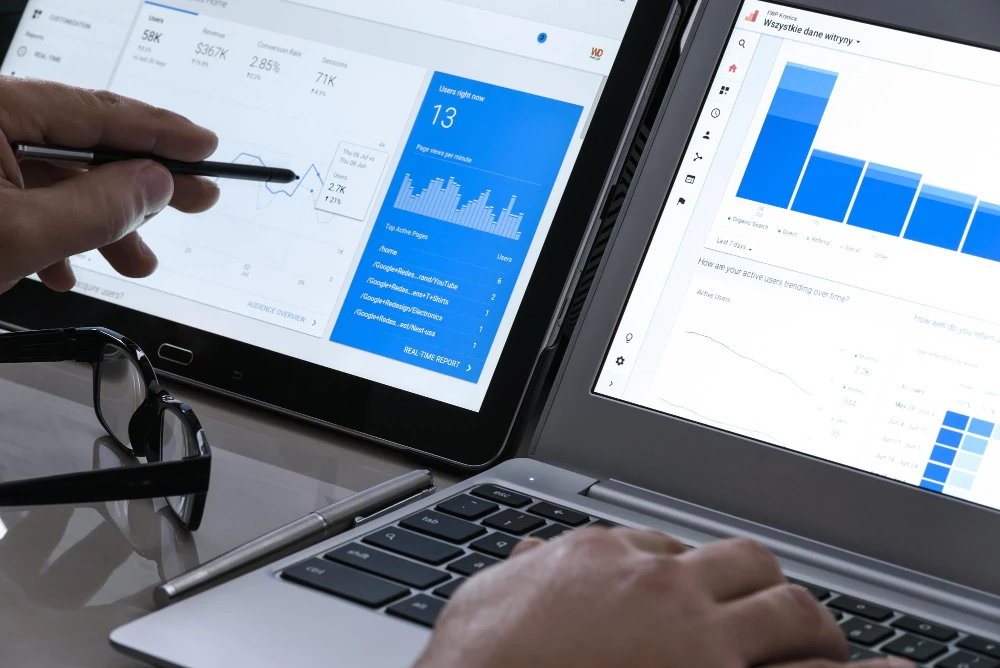
What is GBRAID?

by Lucy Greenaway
Understanding and Navigating Google Ads
In the vibrant world of PPC marketing, Google Ads stands as a giant; a tool with the potential to connect your business to millions of users searching for products, services, and answers every day.
But what makes Google Ads truly invaluable isn't just a reach that is vast and wide; it's the ability to track conversions and data - the moments where interest turns into engagement, and engagement transforms into action.
Google Apps like Google Ads and Google Analytics that offer this ability to monitor user behaviour are what allow businesses to optimise their campaigns, tailor their messages, and ultimately, succeed in their digital marketing strategies.
It's a bit like having a roadmap for your journey; by knowing which turns you need to take to get to your destination faster, you can avoid wasting fuel and time and reach your goal more efficiently.
However, the world of digital marketing doesn't just stand still. It's always evolving, and a significant part of this evolution has been a renewed focus on user privacy. Now, more than ever, it's crucial for businesses to stay ahead of the curve, understand and adapt to these changes, and use new tools and strategies effectively in their ad campaigns.
Understanding the Shift in Conversion Tracking

In recent years, we have seen completely unprecedented advancements in privacy policies from large corporations. But along with these advancements, there's a greater demand for user privacy, and tech giants are responding.
This shifting landscape has led to a significant transformation in how we track conversions, and understanding this shift is paramount for marketers seeking to thrive in the digital arena.
Let's take things back a bit to April 2021. Apple introduced its App Tracking Transparency (ATT) policy, a move that sent ripples through the digital marketing industry.
In essence, the ATT policy gave Apple users greater control over their data, allowing them to choose whether they want to be tracked across websites and apps. They could now opt out of data sharing, a privacy-focused decision that significantly limited tracking capabilities on iOS.
As marketers, we were left with a critical question: How do we continue to accurately measure campaign performance and optimise our strategies in this new privacy-first environment? This is where Google stepped up to the plate, introducing a game-changing solution to this dilemma: WBRAID and GBRAID.
What is GBRAID?
GBRAID stands for Google Braid, and its primary function is to assist in app-to-app conversion measurements. When a user clicks on a Google ad in one app and then takes a desired action (like installing another app or making an in-app purchase), GBRAID helps attribute that conversion to the initial ad click.
For example, if you run an ad campaign promoting your gaming app and a user clicks the ad in another app, then downloads and starts playing your game, GBRAID is the parameter that helps attribute that conversion back to the original ad campaign.
This parameter becomes crucial in iOS environments impacted by the ATT changes, where traditional user-level tracking methods have been restricted.
The difference between GBRAID and WBRAID
Created in response to Apple's ATT policy changes, WBRAID (Web Braid) and GBRAID (Google Braid) are Google's innovative answers to the tracking limitations brought about by ATT.
WBRAID and GBRAID parameters aren't just alternatives to traditional tracking parameters; they represent a shift towards respecting user privacy while still providing marketers with valuable insights.
WBRAID is used for web-to-app measurement, ensuring that we can track conversions when a user moves from a web ad to an app, whereas GBRAID caters specifically to app-to-app conversions.
How GBRAID Works in Google Ads
Worry not, the mechanics of GBRAID are intriguing, engaging, and not as complicated as you might think. Let's delve into the world of GBRAID and unravel the mystery of how it functions in Google Ads.
GBRAID: App-to-App Tracking Made Simple
In its simplest terms, GBRAID is used for app-to-app measurement, particularly for devices running iOS 14.5 and above. Imagine it as a detective, leaving no stone unturned when it comes to tracking conversions from one app to another. But unlike a traditional detective, GBRAID doesn't infringe on individual privacy, complying with the strict rules of Apple's ATT framework.
When a user clicks an ad in an app and is then redirected to another app, GBRAID steps into action. It assigns a unique ID to the click, and this ID is used to link the ad click to any subsequent conversions that occur in the destination app. This crucial tracking allows digital marketers to attribute conversions back to their ad campaigns, providing invaluable data on which ads are effectively driving app-to-app conversions.
GBRAID and ATT Compliance: A Match Made in Heaven
So, how can GBRAID be such an efficient detective, attributing conversions back to ad campaigns, while still being ATT compliant?
The answer lies in its clever design. GBRAID doesn’t attribute conversions to an individual user. Instead, it focuses on holistic reporting. It’s all about the bigger picture, focusing on the overall campaign rather than the intricate details of individual user behaviour.
GBRAID utilises aggregation techniques and de-identification methods to ensure cross-app behaviour cannot be tied back to an individual user. This approach aligns perfectly with Apple’s ATT framework, designed to uphold user privacy by disallowing tracking across websites. With GBRAID, marketers can maintain the efficiency of their ad campaigns while ensuring user privacy is not compromised.
GBRAID and Modelled Conversions: A Partnership for Accuracy
GBRAID doesn’t work alone in its mission to enhance the precision of iOS traffic measurements. It works hand-in-hand with modelled conversions, forming a partnership that ensures accuracy while remaining privacy-centric.
Modelled conversions use data and predictive modelling to provide a comprehensive view of conversion activity. This method doesn’t rely on individual user data but utilises broader data trends to predict conversion likelihood. Factors such as historical conversion rates, device type, browser, and location play a role in these predictions.
When paired with GBRAID, these modelled conversions offer an additional layer of insights, increasing the overall accuracy of measurements on iOS traffic. The end result? A comprehensive, accurate, and privacy-compliant measurement system that provides critical information to optimise your ad campaigns.
The Role of GCLID in the Age of GBRAID

As we stride into an era where privacy-centric changes hold sway, the topic of GBRAID naturally dominates many conversations. This can often lead to a feeling of side lining or perhaps even completely ignoring the good old Google Click Identifier.
However, make no mistake, even amidst the GBRAID buzz, GCLID continues to hold the fort in the world of conversion tracking - and it does so with immense relevance and potency.
How they work in tandem for accurate conversion measurement.
The genesis of GBRAID has not signified the end of GCLID. On the contrary, GCLID still has a role to play, and a crucial one at that. In the vast tides of non-iOS devices, GCLID is guiding the conversion tracking efforts of marketers with its reliable and valuable insights. Upon a user interacting with a Google advertisement, Google automatically appends a distinct identifier to the end destination URL.
This enables the GCLID to transmit data relating to the post-click activity back to Google. Its prowess remains undiminished in the realm of platforms not under the sway of Apple's ATT framework. Hence, the importance of GCLID in today's marketing landscape remains a force to be reckoned with, its relevance undimmed and its effectiveness untarnished.
But here's where things get even more interesting. In the context of the GCLID-GBRAID relationship, it's not a tale of replacement or rivalry. Far from it! Instead, think of them as two sides of the same coin, each bringing unique benefits to the table. They function as a dynamic duo working in perfect tandem to deliver a comprehensive picture of conversion measurement.
The Impact of GBRAID on Digital Marketing Strategies
GBRAID facilitates deeper insights into your ad campaigns on iOS platforms, now offering a much clearer vision. This leads to a marked enhancement in performance metrics. With improved conversion tracking, you can make more informed decisions about ad placement, budget allocation, and target audiences, effectively turbocharging your campaign optimisation.
By providing a more holistic report on conversions and allowing you to accurately measure app-to-app interactions, GBRAID enables you to conduct a thorough analysis of your campaigns. This, in turn, paves the way for data-driven forecasting and strategic planning of your upcoming initiatives.
We understand that this sea of change can be overwhelming, even for the most seasoned digital marketers. That's why we're here to help you navigate these uncharted waters. Don't let the nuances of GBRAID perplex you or stand as a barrier to your marketing success.
Using GBRAID with other web measurement Tools
GBRAID and Google Analytics
The new GBRAID parameter can work with Google Analytics reporting (specifically GA4) to track and analyse ad campaign performance. It does this by interacting with modelled conversions, enabling the system to provide a holistic view of conversion trends while staying within the boundaries of user privacy guidelines set by Apple's ATT.
GBRAID and Google Tag Manager
Google Tag Manager can be used to ensure that this new tracking parameter is implemented correctly. Marketers can create new tags or modify existing ones to include the GBRAID parameter, allowing for accurate tracking of app-to-app conversions in iOS environments.
Remember, both Google Analytics and Google Tag Manager should be set up to correctly capture and handle GBRAID parameters. This will ensure that you're maximising your understanding of campaign performance across all platforms, including those that have adopted stricter privacy measures like iOS.
Helping You With Your Google Ads Strategy
Our team is poised and ready to assist you in integrating GBRAID into your Google Ads campaigns and leveraging it to its full potential. With our expertise, you can confidently ride this wave of change and elevate your digital marketing strategies to new heights.
We invite all business owners eager to navigate this new era of conversion tracking to reach out to us for assistance. Whether you need help implementing GBRAID in your Google Ads campaigns or want more information about implementing a better ad campaign performance, we are here to help - with a free Google Ads Account Review!
Don't let these changes catch you off guard – embrace them and use them to fuel your digital marketing success.